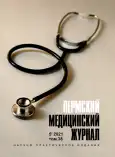Особенности течения беременности и родоразрешения женщин после применения у них программ вспомогательных репродуктивных технологий
- Авторы: Фомина И.В.1, Бойченко М.С.1, Жилина А.С.1, Мартыненко М.В.1
-
Учреждения:
- Тюменский государственный медицинский университет
- Выпуск: Том 38, № 5 (2021)
- Страницы: 61-69
- Раздел: Оригинальные исследования
- URL: https://journals.rcsi.science/PMJ/article/view/96174
- DOI: https://doi.org/10.17816/pmj38561-69
- ID: 96174
Цитировать
Полный текст
Аннотация
Цель. Изучить особенности течения беременности и родов у женщин после их участия программах вспомогательных репродуктивных технологий. Медицинская помощь семьям с бесплодием, в частности путем участия в программах вспомогательных репродуктивных технологий, является важным направлением комплексной государственной политики по содействию рождаемости.
Материалы и методы. Ретроспективное исследование проведено на базе ГБУЗ ТО «Перинатальный центр», г. Тюмень. Проанализированы 237 историй родов женщин, чьи беременности наступили с применением вспомогательных репродуктивных технологий, и 237 историй родов пациенток, чья беременность наступила самостоятельно.
Результаты. Выявлена более высокая частота осложнений беременности у женщин после применения программ вспомогательных репродуктивных технологий: так, отмечено более высокое число преждевременных родов, плацентарных нарушений, истмико-цервикальной недостаточности, а также значительно больший процент оперативного родоразрешения путем кесарева сечения.
Выводы. Наличие исходно большого «багажа» сопутствующих и гинекологических заболеваний у пациенток с бесплодием, чьи беременности наступили с применением программ вспомогательных репродуктивных технологий, приводит к большему проценту осложнений беременности, и высокому числу оперативных родоразрешений.
Ключевые слова
Полный текст
Открыть статью на сайте журналаОб авторах
И. В. Фомина
Тюменский государственный медицинский университет
Автор, ответственный за переписку.
Email: fiv-1982@mail.ru
кандидат медицинских наук, доцент кафедры акушерства и гинекологии
Россия, ТюменьМ. С. Бойченко
Тюменский государственный медицинский университет
Email: fiv-1982@mail.ru
студент лечебного факультета
Россия, ТюменьА. С. Жилина
Тюменский государственный медицинский университет
Email: fiv-1982@mail.ru
студент лечебного факультета
Россия, ТюменьМ. В. Мартыненко
Тюменский государственный медицинский университет
Email: fiv-1982@mail.ru
студент лечебного факультета
Россия, ТюменьСписок литературы
- Zegers-Hochschild F. Assisted reproductive techniques in Latin America: The Latin American Registry. 2013. REDLARA 2020; 20 (2): 49–58.
- Исупова О. Вспомогательные репродуктивные технологии: новые возможности. Демографическое обозрение 2017; 4 (1):35–64.
- Iliadou A.N. The Uppsala–Stockholm Assisted Reproductive Techniques (UppStART) study. Open access 2019; 9 (8): 1–7.
- Бойченко М.C., Жилина А.С., Мартыненко М.В. Анализ результатов вспомогательных репродуктивных технологий в Тюменской области. Актуальные вопросы современной медицинской науки и здравоохранения. Тюмень 2019; 34–36.
- Alviggi C. COVID-19 and assisted reproductive technology services: repercussions for patients and proposal for individualized clinical management. Reproductive Bioligy and Endocrinology 2020; 8(1): 45.
- Jahangirifar M. Dietary Patterns and The Outcomes of Assisted Reproductive Techniques in Women with Primary Infertility: A Prospective Cohort Study. Original Article 2019; 316–323.
- Almasi-Hashiani A. Assisted reproductive technology and the risk of preeclampsia: an updated systematic review and meta-analysis. BMC Pregnancy and Chilbirth 2019; 19 (1): 149.
- Хасанова В.В., Кукарская И.И., Шевлюкова Т.П., Кукарская Е.Ю. Современный подход к комбинированной терапии пациенток с воспалительными заболеваниями органов малого таза. Пермский медицинский журнал 2021; 38 (2): 45–55.
- Матейкович Е.А., Шевлюкова Т.П., Чернова А.Л. Доброкачественные опухоли и опухолеподобные поражения яичников; структура, методы диагностики, тактика оказания медицинской помощи. Медицинская наука и образование Урала 2021; 22 (1): 100–104.
- Елгина С.И., Золотеревская О.С., Захаров И.С., Мозес В.Г. Результативность применения вспомогательных репродуктивных технологий, проведенных в рамках обязательного медицинского страхования. Мать и дитя в Кузбассе 2019; 2 (77): 20–22.
- Шевлюкова Т.П., Чабанова Н.Б., Ермакова А.А., Ермакова П.А. Построение интегрального показателя комплексной оценки и анализа факторов риска варикозной болезни вен нижних конечностей в период беременности. Пермский медицинский журнал 2020; 6: 25–32.
- Трубникова Л.И., Самойлова А.В., Маринова О.А., Милаев С.Г. Клиническая характеристика женщин, использующих методы вспомогательных репродуктивных технологий. Ульяновский медико-биологический журнал 2015; 4: 60–70.
Дополнительные файлы







